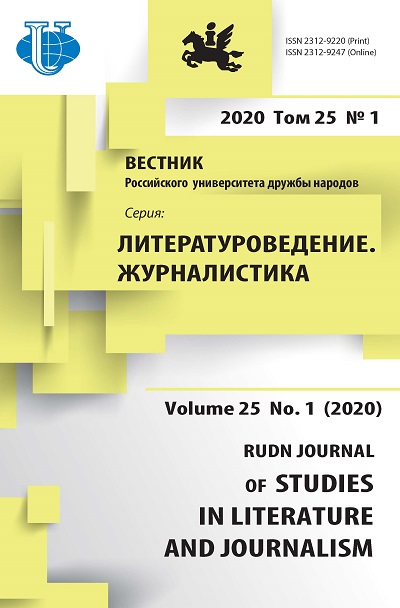The art of ceramics in the works of E.Ya. Danko: “Vase of Chinese Khan”, “Ceramic Cup” and “Chinese Secret”
- Authors: Arzamastseva I.N.1, Liping Y.1
-
Affiliations:
- Moscow State Pedagogical University
- Issue: Vol 25, No 1 (2020)
- Pages: 91-100
- Section: Comparative Studies
- URL: https://journals.rudn.ru/literary-criticism/article/view/23611
- DOI: https://doi.org/10.22363/2312-9220-2020-25-1-91-100
Cite item
Full Text
Abstract
This article is the first try to research the connection between the art of ceramics and word in the work of children's writer and artist E.Ya. Danko. The relevance of the study is due to the need to expand the idea of the image of China in Soviet children's literature of the 1920s. Compared to the history of Russian poetry, the poems “Ceramic Cup”, “Chinese Secret” and the novel “Vase of Chinese Khan” are considered diachronically, and synchronously - in the context of the indestructible myth of Ancient China and the Chinese proletarian revolution. Special attention is paid to the genesis of the ideal image of China in the work of E.Ya. Danko, which traces back to the ideas of F.M.A. Voltaire, M.V. Lomonosov and Russian poets of the XIX - early XX centuries. Works by E.Ya. Danko meets the idea of A.M. Gorky - to create literature on factories, crafts, and technology. In her works about China, upholding the classical understanding of Chinese culture and admiring the talent and hard work of the Chinese people, E.Ya. Danko found a way out of the chaos of the 1920s.
About the authors
Irina N. Arzamastseva
Moscow State Pedagogical University
Author for correspondence.
Email: in.arzamastseva@mpgu.su
Doctor of Philology, Professor, Department of Russian Literature of 20-21 Centuries
1, Malaya Pirogovskaya St, bldg. 1, Moscow, 119435, Russian FederationYang Liping
Moscow State Pedagogical University
Email: lipingyang@yandex.ru
postgraduate student of Department of Russian Literature of 20-21 Centuries
1, Malaya Pirogovskaya St, bldg. 1, Moscow, 119435, Russian FederationReferences
- Zhang, Wenjing. (2013). The literary features of ceramic objects [张文婧.陶瓷器物上 的文学体征性]. A record of historical events of Province Heilongjiang [黑龙江史志] (p. 165). (In Сhinese.)
- Lomonosov, M.V. (2011). Pis'mo o pol'ze stekla [The letter about the use of glass]. In M.V. Lomonosov, Polnoje sobranije sochinenij [Complete works]: in 11 vols. Vol. 8. Pojezija. Oratorskaja proza. Nadpisi 1738–1764 [Poetry. Oratorical prose. Lettering 1738–1764] (pp. 457–469). Moscow, Saint Petersburg: Nauka Publ.
- Ronkina, N.M. (2017). Pojema “Sashka” M.Ju. Lermontova i pushkinskaja tradicija [The poem “Sashka” of M.Yu. Lermontov and Pushkin tradition]. Uspehi sovremennoj nauki [Successes of modern science], 2(2), 61–63.
- Kolobashkin, N.N. (1906). Opisanie Vystavki kitajskih i japonskih proizvedenij iskusstva, promyshlennosti i predmetov kul'ta i obihoda [Description of Exhibition of Chinese and Japanese works of art, industry and objects of worship and household goods]. Moscow, Tipo-lit. D.V. Troitskogo Publ.
- Danko, E.Ya. (1992). Vospominanija o Fedore Sologube [Memories of Fedor Sologub]. Lica. Biograficheskij al'manah [Persons. Anthology biography] (vol. 1). Moscow, Saint Petersburg: Feniks Publ., Atheneam Publ.
- Shaporina, L.V. (2011). Dnevnik [A diary] (vol. 2). Moscow: Novoje literaturnoje obozrenije Publ.
- Staburova, E.Yu. (2002). Vol'ter i Vostok [Voltaire and East]. Vostok – Zapad: Istoriko-literaturnyj al'manah [East – West: Historical and Literary Anthology]. Moscow: Vostochnaja litjeraturja RAN Publ.
- Voltaire, Fr.M. (1868). Filosofija istorii [Philosophy of History]. Saint Petersburg: Typografija N. Neklyudova Publ.
- Sarkisova, G.I. (1993). Vol'ter o Kitae i stanovlenie russkogo kitaevedenija [Voltaire about China and the formation of Russian sinology]. I ne raspalas' svjaz' vremen..: K 100-letiju so dnja rozhdenija P.E. Skachkova [And the connection of times has not broken up..: On the 100th birthday of P.E. Skachkova]. Moscow: Nauka Publ., Vostochnaja litjeraturja Publ.
- Sivolap, I.I. (1975). Vol'ter v sovetskoj literature 1917–1972 gg [Voltaire in Soviet literature of 1917–1972]. Francuzskij ezhednevnik 1973 [French diary in 1973] (pp. 274–283). Moscow: Nauka Publ.
- Morozova, O. (1972). Grani talanta [The verge of talent]. Detskaja literatura [Children's literature], (7), 40–43.
- Bianchi, V.V. (2013). Gorod i les u morja [City and forest by the sea]. Saint Petersburg: Amphora Publ.
- Danko, E.Ya. (1925). Vaza Bogdyhana [Vase of Bogdyhan]. Moscow: Raduga Publ.
- Danko, E.Ya. (1925). Farforovaja chashechka [Ceramic cup]. Leningrad: Gos. izd-vo Publ.
- Danko, E.Ya. (1929). Kitajskij sekret [Chinese secret]. Moscow, Leningrad: Gos. izd-vo Publ.
- Gorky, M. (1955). E.Ja. Dan'ko (1 oktjabrja 1936) [E.Ja. Danko (October 1, 1936)]. In M. Gor'kij, Sobranije sochinenij [Collection of works]: in 30 vols. (vol. 30, pp. 360–361). Moscow: Gosudarstvennoje izdatel'stvo khudozhjestvennoj litjeratury Publ.
- Zhuravlev, S.V. (1997). Fenomen “Istorii fabrik.i zavodov”: gor'kovskoe nachinanie v kontekste jepohi 1930-h godov [The Phenomenon of the History of Factories: the pioneering of Gorky's in the 1930s]. Moscow: IRI Publ.
- Arzamastseva, I.N. (2003). “Vek rebenka” v russkoj literature 1900–1930 godov [“The Age of the Child” in Russian literature of 1900–1930]. Moscow: Prometjej Publ.
- Hellman, B. (2013). Fairy tales and true stories: The history of Russian literature for children and young people (1574–2010). Leiden, Boston: Brill.
















